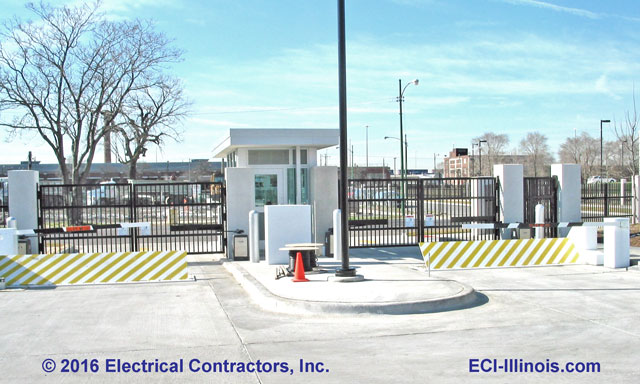
Anti-Ram Vehicle Barrier
Active vehicle barriers (AVB) are generally used at critical access control or entry locations. These active barriers have moveable parts, some of which, or most all of the parts, are power assisted. The systems are manually or mechanically operated to allow or prevent vehicles passing through. The access points may also include inspection of proper credentials to determine authorization and even inspection of the contents of vehicles.
Passive barriers on the other hand are fixed in place and have no moving parts. Their effectiveness relies on their ability to absorb energy and transmit that energy to the barriers’ foundations. Fortified fences, concrete walls, portable concrete barriers, bollards, and even terrain (berms, ditches, landscaping trees and shrubs, etc.), guardrails, medians, etc. are examples of passive barriers.
Our focus here is on active vehicle barriers, of which ECI offers.
Active, crash rated, vehicle barriers are available in many styles (i.e. bollards, anti-ram barriers as pictured above, wedge barriers, etc.), types of movement (i.e. fixed in place, retractable, etc.) as well as drives (i.e. electric, hydraulic, etc.). Crash-rated perimeter barriers are tested using established test methods or rating system. “Rating systems are defined by some combination of the size, velocity, and angle of approach of the design vehicle and the allowable penetration distance.” See our discussion of Crash Rated Bollards for additional information.
To help assist you in specifying and selecting the proper equipment for your particular application, the United States Department of Homeland Security has a reference guide available. The information is titled “Guide to Active Vehicle Barrier (AVB) Specification and Selection Resources” and is available on their Website.
The guide recommends four steps in the selection process of active vehicle barriers:
- Site Planning and Design
- Selection Criteria
- Writing of Specifications
- Selection of Model Specifications
Site Planning and Design includes such factors as –
- Site assessment during which you analyze all physical characteristics of the location.
- Threat assessment determines the potential threats and existing vulnerabilities.
- A plan for the site’s physical security.
Selection criteria falls into many categories such as asking whether a barrier can physically stop a vehicle loaded with improvised explosive devises? Can the barrier meet government certification standards?
Other selection criteria include: Environmental factors such as road and terrain features; the actual physical features of the barrier (size, appearance, makeup) and also included are considerations for the safety of personnel,. security. operations, etc.
The guide goes into many details on writing specifications and offers a template (available for download). All this is meant to help you better communicate with potential contractors.
Details on selection are included, as is a link to a selection tool for crash rated barriers found at https://www.cttso.gov/.
For assistance in selection and installation of active vehicle barriers call ECI at 847.949.0134 or use the link below for contact information.


